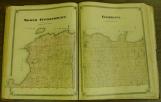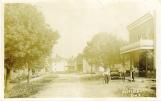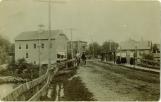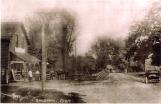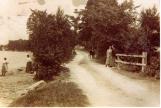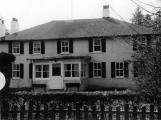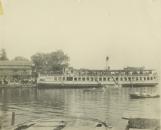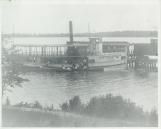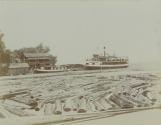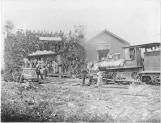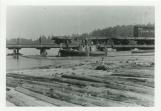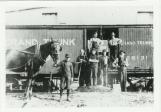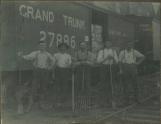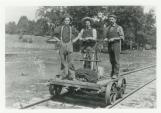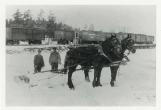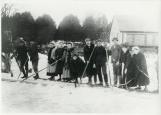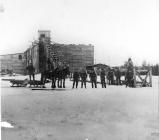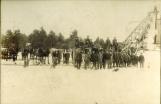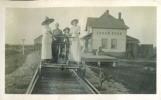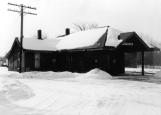

Georgina Pioneer Village
Keswick, Ontario
1
Steamer Enterprise loading and unloading at Jackson's Point.1900
Lake Simcoe, Jackson's Point, Ontario, Canada
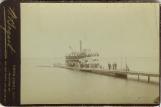
2
"In the settlement of the province, the pioneer at first followed the course of the shores of the lakes, bays, rivers and the smallest streams. And wherever was found an Indian path, it was pursued."-Historical Atlas of York County. Toronto: Miles and Company, 1878
4
Georgina Township, named in honour of George III during the governorshop of Simcoe, was surveyed in 1917 by Duncan McDonald under instructions from Surveyor-General Thos. Ridout. From 1826 to 1970 the township was separated for administrative purposes into two townships: North Gwillimbury to the west and Georgina to the east. The township, comprising 34,996 acres, is characterized by varied soil conditions ranging from good agricultural land to swampy and sandy soil. It was her pine-forested shoreline, however, which produced the most interesting centres of development, and although small pockets developed in Udora, Egypt, Baldwin, Vachell, and Virginia, the three principal settlements in the 19th century were Sutton, Pefferlaw, and the Lake Shore Road.9
North Gwillimbury grew up around four centres: Roche's Point, Keswick, Jersey, Belhaven. Historically, Lake Simcoe and the Holland River formed the principle communication route from the north to the south of Upper Canada, and North Gwillimbury held a beneficial position along this route. "Upper Canoe Landing," in early days, was a site much used by Natives engaged in bartering with the fur traders. A mile and a half further down from the Upper was the "Lower Landing." Here, with the Holland River is about 25 feet wide, was "Pine Fort" also known as "Gwillimbury Fort."Gov. Simcoe, realising the importance of good communications for the new Province, caused a survey of a route from Toronto to Lake Simcoe to be made in 1795. It was called Yonge Street after Sir George Yonge, Secretary of War in the Home Government of 1791. By 1829 a stage coach was able to make daily trips along this route from Toronto to Holland Landing. It provided seats for six passengers and was drawn by four horses. This meant untold benefits for the growing township. In 1821 the total number of inhabitants in North Gwillimbury and Georgina was 272. The next year it had risen to 314 and in 1829, North Gwillimbury alone had 339 inhabitants.
The town of Belhaven, formerly known as "Plug Mount," so named after a gentleman who wore a "Plug" or Stove Pipe Top-Hat when he met the daily coach, was situated at a central point in the township. This was the position of the Town Hall and was the starting place of the daily coach which ran to Newmarket via Keswick, Jersey, Queensville and Sharon.
12
Early in his tenure as Lt. Gov. of Upper Canada, Sir Peregrine Maitland had plans to move the Capital. During the War of 1812 Americans had burned the Parliament buildings at York, and most of the public records. Maitland, with his impressive land-based military career, did not consider that a heavy naval presence on Lake Ontario would secure the safety of York. So he and other Crown officers set about finding a capital for Upper Canada that would be safe from invading Americans. Sir Peregrine believed a waterway could be built from Lake Simcoe to the Ottawa River. Lake Simcoe was already part of the main trade route from Lake Ontario to the Northern Lakes, and then onto the West. Any freight travelling north or south would be confined to well within Canada and no American ships lurking near the border would have opportunity to pillage.13
In 1822 Maitland purchased 200 acres at Roche's Point in North Gwillimbury. Unfortunately for Maitland (and North Gwillimbury), the expense was enormous and no one wished to relocate from Muddy York to yet another swampy wilderness. Maitland was recalled to England and the whole matter was dropped. Over 100 years later the settlement at Roche's Point is still laid out as "Government Reserve," and today Maitland's road names remain unchanged.15
The end of the Napoleonic Era in Europe, corresponding with the end of the War of 1812, resulted in numerous well-educated naval officers requesting land from the government in order to begin a new life in Upper Canada. To these retired, half-pay officers, the lake location and untouched shorelines of Lake Simcoe were most appealing in contrast to the already well cultivated, populated shoreline of Lake Ontario and the St. Lawrence.The lack of roads in Georgina and North Gwillimbury did not stop our earliest citizens. In 1999 a boat similar to a "Durham" boat was found in Lake Simcoe off Jackson's Point. These boats were used by early settlers to transport belongings to isolated settlements. Jackson's Point was settled after the War of 1812 by William Bouchier, a Captain and a shipbuilder in the British Royal Navy. He came to Canada to serve in the British Naval Service on the Great Lakes. He was to command a frigate which was being constructed in 1814 at Penetanguishene. The anchor for this ship is reputedly the one currently resting at Anchor Park in Holland Landing, which was abandoned there at the end of the war. In 1818 William received a large land grant in North Gwillimbury and Georgina. Scott Williamson of the Lake Simcoe Marine Heritage Society has many reasons to believe this Durham boat belonged to William, one of these being the location, at Wm. Bouchier's property.
17
William's younger brother James O'Brien Bouchier, a midshipman in the British Royal Navy, came to Georgina and founded Bouchier's Mills, later known as Sutton. He arrived at New York in 1816 with John Comer. Together they travelled on horseback to Niagara Falls and then by foot to Georgina.19
Another early settler was Lieut. William Johnson (later Captain). Johnson arrived in 1819, also by foot, and, having lost a cow, followed a Native trail to search for it. This is how he came upon an excellent site for a mill. It was this site which in 1823 became the little town of Pefferlaw.Johnson left a diary from 1832 to 1850. In it he records daily activities at his farm. Business at York required him and his workmen to travel by horseback, and occasionally with a cart, though more than one of his workers travelled by foot to Newmarket, Holland Landing, Sharon (Hope), and York.
Thomas Mossington, though not a Navy man, was a civilian employee of the British Navy Office. He travelled to Canada for business as a timber agent. In 1830 he purchased land in Georgina Twp. He wrote to a friend about the journey, asserting that numerous coaches, steamers, and stops in taverns made this an impressive network for communication.
21
On Sunday September 30 1832, William Johnson noted in his diary, "Heard that steamer arrived at Jackson's Point." Ever the efficient Navy man, Johnson's diaries are less than enthusiastic. But what a site this must have been! Even though the Navy men along the shore knew it was coming (most of them were shareholders in the venture), it must have been a spectacular sight.The first steamer stopped at the homes of its shareholders. One of these shareholders was John Mills Jackson, for which Jackson's Point is named. Here he had a warehouse and store for early residents to receive their supplies and mail.
24
Recently a marine railway was discovered in Lake Simcoe. It was here that steamers would be hoisted onto land for storage and repairs. This is where the famous Steamer Enterprise, immortalized as the 'Mariposa Belle' by Stephen Leacock, was dry docked and her machinery removed before being scuttled in deep water. In later years, the wharf at Jackson's Point would become one of the Lake Simcoe's busiest ports for lake excursions by tourists aboard steamers.26
In 1877 the first train rolled into Sutton. The Lake Simcoe Junction Railway was a branch of the Toronto & Nipissing Railway. Service would later be provided by the Grand Trunk and the Canadian National Railways.28
The train arrived with much fanfare; the residents knew it would change their town. There was already the Spring Water Ice Company, cutting ice from Lake Simcoe and transporting it to Toronto by horse and wagon. With the coming of the train the industry exploded. Spring Water Ice Company became Lake Simcoe Ice Company. Other companies entered the area, huge warehouses were built in Jackson's Point. The train, which was extended to Jackson's Point, went onto a railway dock. Alongside this, ice stored in the warehouses was loaded onto freight trains and shipped out.40
In 1906 Georgina Twp. saw a second railway constructed in the area. The James Bay Railway Company laid track from Toroto to Parry Sound. Cedar Brae and Pefferlaw welcomed the freight and passenger service. On November 19 1906, the first regular passenger service from Toronto to Parry Sound began.43
The 3rd Sutton train station is moved to Georgina Pioneer Village in 1977.1977
Sutton, Ontario, Canada
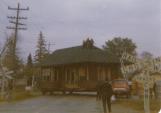
44
Unfortunately the Jackson's Point station did not survive, but luckily the Georgina Historical Society was able to save the Sutton station and make use of the Pefferlaw station.The GHS moved to the site of the Georgina Pioneer Village the Sutton station. It was the third Sutton station. The original was burned badly enough to be condemned after a tree next to it was hit by lightening and fell into the structure. Built around 1900, the second station was itself hit by lightening and burned in 1921. The third and final Sutton Station was damaged by fire, but not so badly as to be demolished. It saw only 6-7 years of passengers and freight until service to Sutton came to an end.
In 1976 the Georgina Historical Society purchased the Pefferlaw station, which was in a sad state and could not be repaired to its former self. It was purchased for parts. The Society knew that the Sutton station was soon coming available. For years it had sat abandoned and been subject to looting and vandalism. Since a fire in June of '76 had badly damaged the station (the freight end had no floor at all), it would need extensive repair before being able to be opened to the public. It was dismantled and moved to the village. The Sutton station was then purchased for $1, cut down the middle, and moved to the village. Lumber from the Pefferlaw station already awaiting its arrival.
Today, visitors to the Georgina Pioneer Village can tour the 3rd Sutton West train station and learn about the railway in Georgina.
